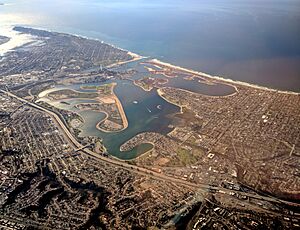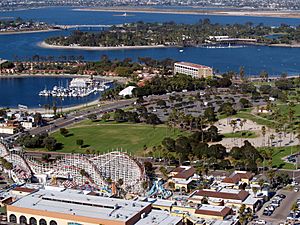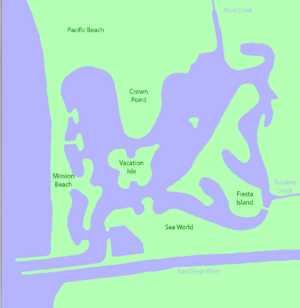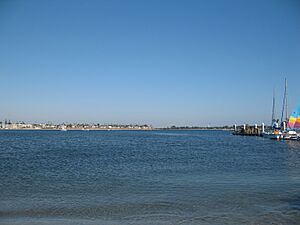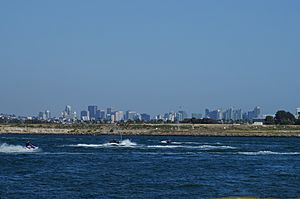Mission Bay (San Diego) facts for kids
Mission Bay is a large, man-made saltwater bay in San Diego, California. It was created from old wetlands and marsh areas. The bay is part of Mission Bay Park, which is the biggest man-made water park in the United States. This huge park covers about 4,235 acres, with nearly half of it being land and the rest water. It's one of the largest city-owned parks in the country.
Mission Bay was built to offer lots of fun activities in San Diego. People love to go wakeboarding, jet skiing, and sailing here. You can also enjoy camping, cycling, jogging, roller skating, skateboarding, and sunbathing around the bay.
The Mission Bay Yacht Club is on the west side of the bay. They hold sailing races all year long. The Mission Bay Sportcenter is also nearby. It offers boat rentals and has a big Youth Camp for kids.
Fiesta Island is a large park area inside Mission Bay. It has a big off-leash dog park. Many events happen here, like charity walks, bike races, and other special events. Even with all the visitors, Fiesta Island is home to many rare and endangered birds and plants.
Mission Bay also hosts the yearly San Diego Bayfair Cup. This is a hydroplane boat race that is part of the H1 Unlimited racing series.
History of Mission Bay
Before the Park Was Built
Long ago, before Europeans arrived, the area we now call Mission Bay was a mix of wetlands. It had lagoons, estuaries, and marshes. Native American villages lived here and used the natural resources. In 1542, Juan Rodríguez Cabrillo called it "Bahía Falsa," meaning "False Bay." The San Diego River used to flow into either San Diego Bay or False Bay. This shifting changed the landscape over time.
Creating the Park
Mission Bay Park was built into a fun water park during the 1940s, 1950s, and 1960s.
In the 1800s, the San Diego River started flowing mostly into San Diego Bay. This worried people because it could fill up the harbor with dirt. So, in 1852, a wall was built to stop the river from flowing into San Diego Bay. This made "False Bay" the main outlet for the river. Later, in 1877, the city built a permanent dam. They also straightened the river channel to the sea. Today, the San Diego River is controlled by walls and no longer flows into Mission Bay directly.
Some early recreation started in "False Bay" in the late 1800s. There were places for hunting and fishing. But floods later destroyed these spots. The name "Mission Bay" comes from a poem written in 1888 by Rose Hartwick Thorpe.
In 1944, a group suggested turning Mission Bay into a tourist and recreation spot. This would help San Diego's economy, which relied a lot on the military.
Starting in the late 1940s, workers began digging and filling the marsh. They moved millions of cubic yards of sand and dirt. This created the land and water areas of Mission Bay Park, which is almost entirely man-made.
The first modern "triathlon" event happened at Mission Bay on September 25, 1974. It was a race that combined swimming, biking, and running. Forty-six people took part in this event.
Protecting Wetlands
About half of Mission Bay Park used to be natural wetlands. But when the park was built, most of these wetlands were lost. Now, only a small part, about 5%, remains. The City of San Diego manages Mission Bay Park. Rules are in place to make sure most of the park is open for public fun. No more than 25% of the land can be used for private businesses.
Rose Creek flows into Mission Bay from the north. It creates a special wetland area called the Kendall Frost Marsh.
The San Diego Audubon Society started a project called ReWild Mission Bay. Their goal is to improve and bring back wetlands in the northeast part of Mission Bay. Wetlands are super important for clean air and water. They also provide homes for local wildlife. The ReWild Mission Bay project is working with the community to create plans to restore these vital wetlands.
Fun at Mission Bay
Mission Bay has about 27 miles of shoreline. Nineteen of these miles are sandy beaches. Eight spots are official swimming areas. Mission Bay is protected to keep its waters clean.
Swimmers and sunbathers love the warm water and calm waves at Mission Bay's beaches. You can find boat docks and places to launch boats. You can also rent sailboats and motorboats. There are paths for biking and walking, and basketball courts. Kids can play at playgrounds. Restrooms and showers are available, and lifeguards are on duty in swimming areas.
On the east side of the bay, there are channels and islands. These are great for windsurfing and water skiing. Some water areas are set aside for specific activities. This includes separate spots for sailing, water skiing, and personal watercraft.
Mission Bay is a top spot in Southern California for rowing, also called "crew." A big rowing competition, the San Diego Crew Classic, happens here every spring. Teams from colleges and clubs compete in rowing races.
Places to Play
Mission Bay is a busy place with many activities on land and water. There are 8 official swimming areas. The west side has many channels and islands, perfect for water sports. You can rent sailboats, motorboats, kayaks, and paddleboards. On land, people enjoy playing in the sand, having picnics, and riding bikes on the 14 miles of paths. You can also play volleyball and fly kites.
Fun attractions at Mission Bay include SeaWorld San Diego, Aqua Adventures for kayaking, the Mission Bay Cross Country Course, and the Mission Bay Golf Course. Don't forget Belmont Park, which has the famous Giant Dipper Roller Coaster and other rides.
Running Cross Country
The Mission Bay cross country course is a 2,000-meter grass loop. It runs along the east side of Mission Bay Park. The first half of the course is mostly flat. The second half has five small grassy hills. This course is home to the San Diego Toreros cross country teams.
Playing Golf
The beautiful Mission Bay Golf Course and Practice Center opened in 1955. It was designed by Ted Robinson. In the early 1960s, he designed the 18-hole course we see today. This course is 2,719 yards long and covers 46 acres. It's the only golf course in San Diego with night lighting. It's a favorite for local golfers. Even Tiger Woods won a Junior World title here!
Walking Dogs
Some areas in Mission Bay Park require dogs to be on leashes. Other areas, like Fiesta Island, allow dogs to be off-leash. However, some parts of the park do not allow dogs at all.
Camping Fun
There is a youth campground on Fiesta Island in Mission Bay. Throughout the year, youth groups and their leaders can enjoy camping. They also get to do water activities and classes during the day. You need a permit to use this campsite. Adults are not allowed to camp overnight unless they are leaders of a permitted youth group.
Fishing
You can fish in most areas of Mission Bay. However, you cannot fish in areas set aside for swimming, water skiing, or personal watercraft. Fishing is also not allowed from any bridge. You might catch fish like corvina, spotted bass, halibut, and spotted sand bass. People use different types of fishing gear, including traditional rods and reels, and fly fishing.
Birds of Mission Bay
Mission Bay Park is home to many rare and endangered birds. One important bird is the California least tern. From April to August each year, a special program helps protect this bird. It nests at four sites in Mission Bay Park. The number of California least terns has grown a lot since it was put on the endangered species list. Most nesting areas are fenced off to protect the birds from people.
Sometimes, other animals like skunks, opossums, and even abandoned cats and dogs can harm the tern chicks. Wildlife experts work with different groups to safely trap these animals. This helps protect the least tern nesting sites. These sites are located on North Fiesta Island, Mariner's Point, Stoney Point, and a small island called "Government Island."
Visitor's Center
The San Diego Visitor Information Center was built in the northeast part of Mission Bay in the 1960s. It helped visitors until it closed in 2010. The building was later turned into the Mission Bay Beach Club, which opened in October 2021. It's now a place with different facilities for visitors.


